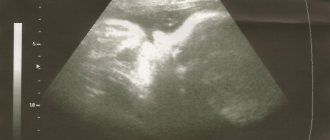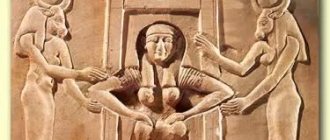Childbirth is a physiological and psychological stress for the woman in labor, as well as a difficult process for the fetus. The mother’s strongest desire is for the birth to take place without complications, with the minimum possible pain, and, of course, for the child to be born healthy.
Many women are afraid to experience pain during labor and delivery of the baby and worry, expecting torment. Physiology proves that the fear of pain maintains and even intensifies it. Adrenaline released into the blood causes vasoconstriction, especially in the abdominal organs, increasing blood pressure and oxygen deficiency. Against this background, spasm of the muscles of the uterus occurs, which gives pain. And the circle closes...
Nowadays, future parents have the opportunity to attend childbirth preparation courses, and there are also enough sources of information that provide the experience of childbirth studied and generalized by physiology. Even before giving birth, pregnant women can learn how to behave during this process and how they can help themselves endure contractions.
Start of labor
At the beginning of labor, the uterus periodically contracts, and this causes a painful sensation in the lower abdomen. The intensity and duration of contractions gradually increase, and the interval between them decreases. Contractions can last for several hours.
It is natural for a pregnant woman to want to find a way to reduce pain for herself, but this is also important for the fetus. Severe and prolonged pain can disrupt the rhythm of a woman’s breathing and heart function, which in turn reduces the supply of oxygen to the fetus. Pain, coupled with emotional worries for the child, tires the woman in labor, and her labor may weaken and even stop. If there are medical indications, then you can resort to pharmacological pain relief for labor, but many pregnant women prefer non-drug pain relief methods.
How to reduce pain before and during contractions
There are a fairly large number of ways that will help relieve pain, both during labor and childbirth. These include:
- special breathing technique;
- correctly selected poses;
- warm shower;
- massage;
- medicinal painkillers;
- music.
It is best for a woman to inquire about these methods in advance, even during pregnancy, to know how to use them and use them when rush hour comes, moving from one to another, combining methods.
Ways to ease contractions
If the pregnancy proceeds without complications and labor begins on time, then during the period of contractions a woman can use different techniques and positions to reduce her pain.
- Walking during contractions is a great way to make yourself more comfortable and also speed up the onset of the main stage of labor. When contractions are still rare, you can even go outside and take a walk near your home, and upon arrival at the maternity hospital, walk around the ward. It will be useful when walking from time to time to raise your legs bent at the knees high. This will improve blood flow in the lower abdomen. In an upright position, gravity helps labor, and the fetus descends into the pelvis faster.
- While contractions are rare, the cervix has not yet dilated, and the water has not broken, you can take a shower or a warm bath.
- In addition to the growing pain from contractions of the uterus, back pain is added, provoked by the weight of the fetus itself. To ease the condition during a contraction, you can:
- standing, lean your back against a support or rest your hands on the wall, on the back of a chair or bed;
- place your leg bent at the knee on a high support, for example, a chair, and lean on it;
- if a partner is present at the birth, you can use the “slow dance” pose: hug your partner by the neck, shoulders or waist, lean on it or even hang and sway, as if in a dance;
- squat down, leaning your back against a wall or chair; it will be convenient to place your back between the knees of your partner sitting on a chair;
- sit on a chair, the edge of the bed or a fitball, rest your hands on your spread knees and sway slightly;
- getting down on all fours - this not only brings relief, but also helps relieve the pressure of the fetus on large blood vessels; during intense contractions, a kneeling position with your chest resting on a bed or fitball helps;
- “baby pose” is a type of pose on all fours (legs spread wide apart, supported by elbows or arms extended forward); it is useful when the baby’s head is already pressing on the pelvic tissues, and the dilation of the cervix is still insufficient.
All fours and other positions to relieve pain and ease labor pains
The birth of a child is an amazing event. However, a joyful meeting with a baby is preceded by childbirth, accompanied by painful contractions. There are many means to alleviate the condition of a woman in labor during this period. You can reduce pain and make contractions more effective, including by adopting various poses.
Contractions and pushing: features of the two stages of labor
The first stage of labor begins with the appearance of regular contractions, while the intervals between them should decrease, and the contractions themselves become more painful and longer. Typically, in primiparous women this period lasts up to 9–12 hours, in multiparous women – up to 7–8 hours.
Contractions are contractions of the muscles of the uterus that promote the movement of the fetus along the birth canal. To give birth to a baby, the cervix must dilate at least 10–11 cm.
When the cervix is completely open and the fetal head has dropped low enough, the woman in labor has a desire to push. From this moment on, the woman is transferred from the prenatal ward to the delivery room. The second period begins - pushing.
Contractions are replaced by pushings, which are repeated every 2-3 minutes, and their duration reaches 60 seconds. The mother's task is to listen to the midwife's instructions and push effectively at her command.
The duration of the pushing period is from 15 minutes to an hour.
Poses to reduce pain and ease contractions
Every woman experiences contractions differently. Some people feel relief moving around the ward, while others prefer not to make unnecessary movements.
Using different positions combined with proper breathing can help reduce pain. If the first stage of labor proceeds without complications, the doctor gives the woman freedom in choosing a position during and between contractions.
The most comfortable body position is determined experimentally. You can practice in advance.
On knees
The woman in labor lies on the bed or on the floor, leaning on her knees and palms, with her legs apart and her pelvis below her head. In this position, the uterus does not put pressure on large blood vessels, and the perineal muscles are relaxed. Often, the all fours position is recommended by obstetricians if a large newborn is expected.
On fitball
A fitball is a large gymnastic ball that is used, among other things, to relieve tension from the muscles of a woman’s pelvis and spine during contractions. In addition, such exercises improve blood circulation in the pelvic area of a woman in labor and reduce pain.
The main condition is that the ball must be inflated with air by approximately 60–70% of its volume. This will ensure a comfortable and stable position for the woman in labor on it, and will not interfere with the advancement of the fetus along the birth canal.
Effective exercises on a fitball during contractions:
- A woman sits on the ball with her legs spread wide and bent at the knees and hip joints, while her feet should rest firmly on the floor. You can alternately perform smooth movements of the pelvis (in a circle, in the form of a figure eight, back and forth, left and right).
- In between contractions, the woman in labor can take a knee-elbow position, with her knees resting on the floor, and her arms, chest and head placed on the ball. This will help you better relax your lumbar spine and gain strength before a new contraction.
Poses with a partner
Nowadays, many maternity hospitals practice partner births. For support during labor, the expectant mother can invite her husband or someone close to her (mother, friend, etc.).
The best positions with an assistant during contractions:
- The woman in labor is facing her husband, with her arms wrapped around his neck, her legs bent. He supports the woman in the armpits, taking most of the weight onto himself.
- The partner supports the woman from behind, clasping her in the armpits. At the same time, the pelvic muscles relax as much as possible, pain is reduced.
- The woman in labor sits on a fitball, her husband supports her from behind, and he can massage the lumbar and sacral area. In between contractions, light stroking movements are preferable; during contractions, more intense ones are preferred.
Standing
Often women prefer to endure contractions on their legs. From an anatomical point of view, this position is considered the most correct, especially at the initial stage of contractions. When a woman is in an upright position, the uterus and fetus are located on the same axis, the baby's head presses on the cervix, promoting its opening.
During stronger contractions, a woman can lean on a windowsill, headboard or chair. In this position, due to the deviation of the abdomen, the back muscles relax, and the woman can rest between contractions.
What is the best way to give birth (postures for the pushing period)
The period of pushing can be divided into two phases. When a woman first feels the desire to push, the fetal head is still high in the birth canal, so it is more natural and comfortable at this moment to be in a standing position, on all fours or squatting with legs wide apart; you can also use a fitball. In all these cases, gravity facilitates the advancement of the fetus.
From the moment when the baby’s head is low enough, in most maternity hospitals women in labor are asked to sit on a special chair (Rakhmanov’s bed) lying on their back with the head end raised. This ensures control by medical personnel over the birth of the child.
During the pushing period, during each pushing, the woman needs to raise her head and tuck her chin to her chest, with her legs spread wide and bent at the knees, rest against the special handrails on the chair. Such actions help to relax the muscles of the perineum as much as possible and tighten the abdominal muscles.
In some maternity hospitals, women are given the choice in which position to give birth. She can sit half-sitting, leaning her back on a fitball, or use any other positions described above.
In what cases does a woman in labor have no choice?
The course of labor does not always allow the expectant mother to be in a free position. Moving around the room or being in an upright position can aggravate the situation and negatively affect the well-being of the mother or fetus.
Complications during childbirth, in which the doctor strongly recommends remaining in a lying position:
- breech presentation of the fetus;
- premature delivery;
- rapid labor;
- threat of bleeding;
- intrauterine growth retardation.
Source: https://www.oldlekar.ru/rody/shvatki/poza-na-chetverenkah.html
Postures during childbirth
During the preparatory stage of childbirth, a pregnant woman can move and choose a comfortable position and body position. When the cervix is fully dilated, obstetricians conduct continuous monitoring of the fetus and the woman in labor and, upon arrival, forcefully place her on the birthing bed.
There is an effective pattern of movements for a woman in labor in exactly this position, which promotes productive pushing. A woman, lying on her back, bends her head and presses her chin to her chest, holding on to special handrails and raising her upper body almost to a sitting position. When the woman in labor lies on her back, it is more convenient for the obstetrician to monitor how the fetal head is shown, prevent perineal ruptures and deliver the baby.
But progressive doctors say that giving birth lying on your back is unnatural for a woman, and that this position makes it difficult for the fetus to pass through the birth canal. It’s probably strange for older generations of women to hear this: “How could it be otherwise? This is how we gave birth, both our mothers and their mothers!” In fact, there is no such position in the childbearing traditions of different nations. Women have given birth lying on their backs since births began to be attended not by midwives, but by obstetricians. It is for doctors who control the process of the birth of the child that this position of the woman in labor is convenient.
Many clinics already practice vertical childbirth, for which special chairs have been installed. A woman can push while kneeling or squatting.
Childbirth position: how to choose the best one?
The process of giving birth to a child is complex and responsible, and therefore requires a certain awareness, effort and physical preparation from the pregnant woman. When a woman behaves incorrectly during childbirth, her body begins to quickly get tired. That is why it is important to know what positions are available for childbirth and how to choose the most comfortable one.
Correct birth positions are of great importance for natural pain relief and ease of labor. During childbirth, especially in the first period, you need to actively move and take different positions. The worst thing you can do is just lie there.
The expectant mother needs to familiarize herself with childbirth positions in advance and choose the best option, taking into account the characteristics of her health and the condition of the child.
What kind of poses are these?
Birth positions are those body positions during childbirth that a woman usually takes, in which she feels most comfortable and at ease when giving birth.
In these poses, you can wait out contractions, breathe diaphragmatically, or do a pain-relieving massage. You can push in the same positions while helping the baby to be born.
Choosing a position during childbirth is an intuitive process, so a pregnant woman should listen to her body, and it will tell you.
To help expectant mothers, a complex of osteopathic gymnastics for pregnant women was created. It consists of birthing positions and movements that help the body adjust to childbirth.
Having mastered it during pregnancy, you will make childbirth easier for yourself, because it will be easy and comfortable for your body to take familiar positions that will help open the pelvis, ensure the correct position of the head and the advancement of the baby, or help you wait out too active attempts.
It is worth studying these poses well, making them familiar and easy, then during childbirth you will be able to intuitively choose the appropriate and effective ones for you.
Postures during contractions
During contractions, choose those positions in which you feel comfortable at the moment. Try to take various comfortable positions, hang on handrails, walk around the room, use a special fitness ball (fitball). If your water hasn't broken yet, you can take a dip in a bath of warm water. A non-hot shower can also help relieve pain during contractions.
Pain during contractions will be reduced by a position in which the woman stands, leaning on a wall, back, etc. This way, the expectant mother can transfer her body weight to her arms and relax a little.
If a pregnant woman has back pain, you can use the “cat pose”: squat down or hang on her husband’s neck so that her belly sag.
Only trained women can take the lotus position and only during labor.
If the baby's head is already pressing on the pelvic floor, and the cervix itself is not yet fully dilated, you can try the “baby position”. A pregnant woman should kneel down and spread them wide enough. A woman needs to place something soft and large, such as a pillow, under her breasts.
Postures during childbirth
Previously, women gave birth only in the supine position. Currently, a woman in labor has the right to choose.
Although it has long been known that the position on the back is the most comfortable for doctors, it is also the most uncomfortable for the woman in labor and her child.
In a lying position, the uterus may contract ineffectively, and the cervix dilates slowly. Childbirth in the supine position is good when labor is expected to be rapid or rapid.
Let's look at birth positions in more detail.
BIRTH POSITION No. 1 – lying on your side
This position is very convenient if the cervix is almost open. A woman should lie on her side with her knees bent. You can put a pillow between them.
To practice this pose, lie down on your comfortable side. During labor, this should be the side where the baby's back is located. Place a bolster, pillow or hand under your head and between your legs. This position is suitable for resting during childbirth. In any maternity hospital, a woman can take this position, even if she is not allowed to actively move.
This position of the mother's body will help the correct installation of the head in the birth canal and reduce the likelihood of injury to the baby. In this position, it is comfortable for a pregnant woman to relax, practice relaxation, practice diaphragmatic breathing and simply fall asleep.
BIRTH POSITION No. 2 – on all fours
Choose a comfortable place - a bed or rug. This pose is good for contractions and will help reduce pain in the back area. Rock back and forth like a ball. These actions will relax the muscles of the perineum and promote better dilation of the cervix. We should also not forget about diaphragmatic breathing.
BIRTH POSITION No. 3 – on all fours with an elevated pelvis
This position helps stop pushing when the urge to push appears, but the cervix has not yet fully dilated. From a position on all fours, you need to lower yourself onto your forearm and rest your head on your hands. Take a double inhale and a long exhale with your mouth open (UV-UV-fu-u-u-u-u). Breathing like a dog has the same effect. This way you can “breathe out” the fight.
BIRTH POSITION No. 4 – sitting or kneeling, leaning on a support of varying heights
Sit on your knees, toes together, heels apart, back straight. Use diaphragmatic breathing.
Try different variations of this pose:
• sitting on your knees, lie forward on a low support;
• sitting on your knees, lean your straight arms on your knees or on a high support;
• kneeling, lean on a low support (back horizontal).
It is especially important to train this position in advance and get used to it, because it is quite difficult to stand and sit for a long time if you are not used to it.
BIRTH POSITION No. 5 – standing with your back against the wall (on your partner)
Stand against a wall or have a helper support you from behind. Legs wider than shoulders, bent, back straight (lower back pressed against the wall). Use diaphragmatic breathing.
BIRTH POSITION No. 6 – standing with high support
Rest your elbows on the wall or an assistant, rest your head on your hands. Use the back of a stable chair or a tall chest of drawers as support. It’s good if you can use various options, then during childbirth the body itself will choose the optimal height of support. Don't forget about diaphragmatic breathing.
BIRTH POSITION No. 7 – standing without support
At the time of birth, the woman in labor should bend her knees, spread her legs wide and tilt her torso slightly forward. Mom needs to be supported from behind so she doesn’t fall. While the baby's head has not yet appeared, the pregnant woman can make gentle rotational movements with her hips. The good thing about this position is that the perineum relaxes better, and the risk of ruptures is significantly reduced.
BIRTH POSITION No. 8 – squatting
Knees apart, heels on the floor, back straight. You can stagger left and right. You can squat not only on the floor, but also on any comfortable and stable surface: on a bed or even on a sturdy table. In this case, let your assistant and midwife support you.
Swinging on a half-inflated exercise ball or soft, low bag of balls, or even with a children's inflatable ring inside is also a good variation of this pose. Just make sure that the surface on which you are sitting is soft and elastic.
You cannot sit on a hard surface during childbirth.
Vertical positions during childbirth
Poses 5-8, which give the pregnant woman’s body a vertical position, create a number of advantages during childbirth: we are talking, first of all, about maintaining normal blood supply to the uterus and placenta, and the force of gravity will help the baby move towards the exit. Vertical postures combined with diaphragmatic breathing help expand the birth canal, which means it makes it easier for the baby to be born.
However, there are situations where vertical positions during childbirth may be undesirable or even dangerous.
These are cases when intervention in the birth process is necessary: with premature pregnancy and premature birth, with signs of intrauterine growth retardation of the child, with rapid or rapid labor.
Then the woman will most likely be asked to lie down. But even in this case, the side-lying position (birth position No. 1) will be more physiological and better for successful non-traumatic birth.
Lying down you can't move
Unless there are serious medical conditions, avoid a stationary position while lying on your back. It is convenient for doctors and obstetricians, but is completely unsuitable for the mother and baby. This position is not at all physiological. There are more correct and effective poses for both contractions and pushing.
Help yourself with movements: walking, swaying your pelvis left and right, back and forth, circular movements, oscillations on a fitball significantly relieve pain from contractions. Throughout labor, practice diaphragmatic breathing, which provides the baby with enough oxygen, relieves contractions and reduces trauma during childbirth.
Discuss with the maternity hospital staff in advance your right to choose any birth positions and defend it together with an assistant, if necessary. Natural birth positions and movements during childbirth help avoid injury to mother and baby and significantly facilitate labor, making it less painful.
Perform daily exercises, training optimal birth positions, to help your body tune in to natural childbirth. Choose any comfortable positions, combine them with movement and proper breathing - then your birth will be easier, and the baby will be able to meet you faster. Learn pain-relieving massage in advance and practice it with an assistant.
So, in which position to give birth is up to you, but remember: in any position you need to be able to relax. Listen to your obstetrician's recommendations and set yourself up for a successful result!
Source: https://stykit.com.ua/ru/interesting/statti/poza-dlja-riv-k-ybt-njshchu
Situations during childbirth when a woman is advised to lie down
Unfortunately, not all pregnant women have a sufficient degree of freedom during contractions to take a comfortable position. For some medical indications, a woman is recommended to lie down:
- stimulation of labor;
- premature birth, delayed fetal development;
- breech presentation of the fetus;
- rapid birth.
It is more difficult to endure contractions in a horizontal position, and breathing exercises and sacral massage will come to the rescue. In such a situation, the help and support of a woman in labor from a doctor, partner, or doula is simply invaluable.
Lying on your side greatly facilitates your well-being, as this reduces the pressure of the uterus on the vessels. In this case, the legs are bent at the knees and positioned as when running - the upper leg is in front, the lower one is laid back. A pillow placed between the legs increases the comfort of the pose. To make it easier for the doctor to monitor the birth of the baby, the bent leg, located on top, is raised and held by the woman in labor, an assistant, or a special device.
During labor, no matter what position or posture the woman in labor is in, it is very important that she helps herself to rest and restore the rhythm of her breathing in the interval between contractions. While waiting for the next uterine contraction, you need to control your emotional state. Maximum relaxation will help the cervix open, and it will be easier for the baby to move through the birth canal.
Birth positions and movement during childbirth
The birth of a new life is like a miracle. However, childbirth is 15–20 hours of hard work. Help your body cope with the work by using birth positions and movements.
Birth positions are body positions in which a woman in labor feels most comfortable and comfortable. They are natural for a woman giving birth and help relieve pain from contractions, maintain strength and move the baby towards the exit of the pelvis.
The article talks about birth positions for resting and waiting out contractions and vertical birth positions suitable for contractions and pushing. and the drawings will help you understand how to move in each of the birth positions. Let's also talk about how to remember these movements in your own childbirth, and how to use them in the maternity hospital.
Birth positions. Fragment of the video tutorial “Preparing for natural childbirth”
Birth positions are similar among women of different nationalities and cultures. No one can tell you in advance what position you will feel good in. Try each position during pregnancy, try it on yourself, breathe. And during childbirth, listen to your body, it will tell you.
“A woman, sheltered from danger and prying eyes, often prefers to give birth in positions characteristic of mammals, for example, on all fours.”
M. Oden, obstetrician, author of books on natural childbirth
We recommend combining birth positions with diaphragmatic breathing. This is when when you inhale, your stomach expands, not your chest. According to osteopathic doctors, healthy people breathe like this from birth. During childbirth, this type of breathing helps open the cervix, expands the birth canal and relieves pain.
Read more in the “Guide to Preparing Parents for the Birth and Raising of a Healthy Child” and the article “Diaphragmatic Breathing during Childbirth and Pregnancy.”
Labor positions for experiencing contractions and resting between them
When.
Contractions are the first stage of labor. It usually lasts from 5 to 18 hours. The woman’s task is to relax, breathe and conserve strength for the next stage - pushing. Poses that help reduce pain and relax between contractions are suitable for this.
Lying on your side
For what.
For rest during childbirth. Helps ensure proper insertion of the head into the birth canal and reduces the likelihood of injury to the baby.
How.
Lie on your side with the baby's back facing. Place a cushion, pillow or hand under your head.
Place one or more pillows between your legs. Even if you are not allowed to move freely in the maternity hospital, this position will help you survive the period of labor. During pregnancy, this position is convenient for relaxing, practicing diaphragmatic breathing and simply falling asleep.
To train, lie on your comfortable side.
On knees
For what.
Breathe out the fight. Helps reduce back pain. Rocking in this position relaxes the muscles of the perineum and helps open the cervix.
How.
Sit in a comfortable place: on the bed or on a rug on the floor. Rock back and forth - imagine yourself as one big ball. Use diaphragmatic breathing.
Pose option.
Asymmetrical birth position. Helps the baby's head take the correct position. Get on all fours, place your right foot forward, next to your right hand. Rock back and forth, breathe. Change your leg. During childbirth, choose the option that is convenient for you.
On all fours with a raised pelvis
For what. To stop pushing. Helps curb the urge to push if the cervix is not yet fully dilated.
How. From a position on all fours, lower yourself onto your forearms and rest your head on your hands. Take a double inhale and a long exhale with your mouth open (oof_uf_fu_u_u_u_u). Or breathe like a dog.
Sitting or kneeling, leaning on supports of varying heights
For what.
Breathe out the fight. You can rest between contractions if lying down is uncomfortable and you are tired of standing and walking. In this position, it is convenient for an assistant to give you a relaxing back massage.
How.
Sit on your knees, toes together, heels apart, back straight. Practice in advance; if you are not used to it, your legs will quickly become numb. Remember about diaphragmatic breathing.
Variants of this pose:
sitting on your knees, lie forward on a low support, sitting on your knees, lean your straight arms on your knees or on a high support,
kneeling, lean on a low support (back horizontal).
Birth positions on all fours are suitable for the entire period of labor. You can wait out contractions in them, rest between them, and even push. In poses on all fours with a freely hanging belly, the load is removed from the spine, back and abdominal muscles. The weight of the child does not press down, the abdominal muscles relax, reducing pain. In these positions it is easier to endure contractions and save strength for pushing.
Vertical positions during childbirth
When.
In the active phase of the first period, contractions repeat every 3–5 minutes and last about a minute. The painful sensations intensify. The dilation of the cervix reaches 5–8 cm, and the time for pushing is approaching. Vertical labor positions will help speed up labor by promoting dilatation of the cervix.
For what.
Vertical postures combined with diaphragmatic breathing expand the birth canal, making it easier for the baby to be born. In a vertical position, the force of gravity helps the baby move towards the exit. Normal blood supply to the uterus and placenta is maintained. (See “Guide to Preparing Parents for Having and Raising a Healthy Child”)
Standing with your back against the wall (on your partner)
How.
Stand near a wall or have an assistant support you from behind. Legs wider than shoulders, bent, back straight (lower back pressed against the wall). Use diaphragmatic breathing.
Standing on a high support
How.
We lean our elbows on the wall or an assistant, put our head on our hands. You can use the back of a stable chair or a tall chest of drawers as support. It’s good if you have different options at hand, then during childbirth the body itself will choose the optimal height of support. Breathe with diaphragmatic breathing.
Standing without support
How.
Legs wider than shoulders, bent, back straight. We swing left and right. You can do it as a couple, holding hands. This dance will support you and help your baby progress. Don't forget about diaphragmatic breathing.
Squatting
For what.
The most open vertical birth position.
Helps expand the pelvic outlet. You can push in this position. How.
How. Sitting in this position requires practice. Knees apart, heels on the floor, back straight without bending forward. We swing left and right.
You can squat not only on the floor, but also on any comfortable and stable surface: on a bed or on a sturdy table. In this case, have your assistant and midwife support you. Pose option.
Swinging on a half-inflated fitball or soft low bag of balls.
The surface on which you sit should be soft and resilient. You cannot sit on anything hard during childbirth.
During the active phase of labor, when contractions are long and painful, use vertical labor positions. They speed up the dilatation of the cervix, open the pelvis and help speed up labor. Move actively between contractions; if you are tired, lie on your side. If the midwife allows, you can push in vertical positions, helping the baby to be born.
How to remember
During the birth process, remembering some pictures of birth positions from the Internet is not an easy task. Reinforce theory with practice. Try each pose during pregnancy, breathe in it with diaphragmatic breathing. If you practice every day, gradually memorize all the variations of birth positions.
During childbirth you will not have to consciously remember anything - all movements will be intuitive. The position you like during training will not always be comfortable during childbirth. We conducted a survey of women who studied at the Vasilisa School of Parents.
10 out of 15 responded that during childbirth they preferred a different position than the one they had chosen in advance.
Anna: “During pregnancy, I liked the asymmetrical position on all fours. And during childbirth it turned out to be more comfortable to lie on your side and stand leaning on the headboard.”
The secret is simple: to remember all the poses, train and repeat them all. To help, we offer a complex of osteopathic gymnastics for pregnant women. It consists of birthing positions and movements that help the body adjust to childbirth. Every day, 10 minutes of gymnastics and all birth positions will become familiar and easy for you. During childbirth, you will be able to intuitively choose the most suitable and effective ones.
How to use birth positions at home and in the maternity hospital
At home.
Any poses that are convenient and comfortable for you. Your task is to get ready for childbirth, maintain strength, relax and rest. Read more about the first stage of labor in the article “First stage of labor – contractions, what to do.”
In the maternity hospital.
There are rules here. The most convenient birth position for doctors and obstetricians is a motionless position lying on your back. But this position is not suitable for the woman in labor and the child because of its unnaturalness. This pose is not in the traditions of any people in the world.
Therefore, a compromise is needed. Agree in advance what is allowed and what is not. Discuss with the maternity hospital staff in advance your right to choose any birth positions during contractions and defend it together with an assistant, if necessary.
Examinations and CTG can be done in a lateral decubitus position.
Maria: “We agreed with the midwife that while the contractions are going on, I can stand, lie or move as I feel comfortable. The fitball helped a lot; I leaned on it while standing and sitting on my knees. And she breathed. I also liked to crawl on all fours on the bed. It probably looked funny, but it really made it easier for me.” .
When medical intervention is required during childbirth, upright postures are undesirable. The woman in labor will be asked to lie down in the case of: premature pregnancy and premature birth, rapid labor (less than 4 hours), rapid labor (less than 6 hours), if there are signs of intrauterine growth retardation.
Lie on your side. For pain relief, use diaphragmatic breathing and sacral massage.
Labor positions help the progress of labor. In most maternity hospitals, during contractions, a woman in labor can take any position that is convenient for her. Before pushing, your midwife will tell you the optimal position. How to choose a maternity hospital for a natural birth, read the article “Partner natural childbirth in a maternity hospital - choosing a maternity hospital.”
Movement and breathing for an easy birth
Labor positions and proper breathing are free and easy ways to ease painful contractions. Study, practice, find your most comfortable and favorite one for relaxation. Train a helper if you take him with you to the birth.
Help yourself with movements, this also relieves contractions: walking with your knees raised high, rocking your pelvis left and right, back and forth, circular movements, cross crawling, swinging on a fitball.
During childbirth, use diaphragmatic breathing, which provides the baby with enough oxygen, relieves contractions and reduces trauma during childbirth. Learn pain-relieving massage in advance and practice it with an assistant.
Natural birth positions and movement during childbirth help avoid injury to mother and baby and make labor easier, making it less painful.
Have an easy birth!
Source: https://proroditelstvo.ru/articles/rody/vo-vremya-rodov/rodovye-pozy-i-dvizhenie-v-rodakh/
Preparing for childbirth is the key to its success
The experience of many women confirms the enormous benefits of physical and mental preparation for childbirth. Reading literature on pregnancy and childbirth, attending courses, analyzing various possible situations and practical exercises help to find the right solution already during the actual process. Obstetric statistics confirm that women who come to childbirth “fully armed” are less likely to develop complications during childbirth and the postpartum period.
Analyzing the advantages of childbirth in the USA, it is worth emphasizing that American clinics conduct informative courses for future parents and create the most comfortable conditions for pregnant women and women in labor. The equipment and amenities in the prenatal wards, as well as the attentive attitude of doctors and staff to the needs and desires of laboring patients, help them endure the difficult period of labor and give birth easily, without negative stress. After giving birth, mothers are not exhausted, but confident and happy. They greet their children with positive emotions, which, of course, has a positive effect on the well-being of all participants in the process.
]SunFlower Family[/anchor] wishes all pregnant women health, good luck and self-control during childbirth and invites you to give birth in America!
TOP 3 best positions for childbirth
Of course, childbirth is a natural process, and a woman can intuitively take the position in which she will be most comfortable during the period of contractions and pushing.
But, in addition to the fact that in maternity hospitals there is a custom of placing a woman in labor on her back - in the most uncomfortable and painful position, pregnant women themselves, out of ignorance, take positions in which labor slows down or becomes more painful, and more often, both.
I made the same mistake myself. When I gave birth to my son, it was my first birth, my midwife tried to influence me and advised me to change my position while pushing, but I didn’t want to move, I didn’t want to listen to anyone, and as a result, the most painful period for me was about 40 minutes, which is quite a lot. .
During the second birth - with my daughter - I listened to myself more carefully and looked for comfortable positions, in addition, at the right moment, my midwife asked me to change the position in which I had been for about an hour and was starting to get tired... - and as soon as I changed it - lo and behold, my daughter was born in 3!!! minutes!
Almost two years passed after this, during which time I consulted many expectant mothers and researched the topic of childbirth more deeply. And now I can confidently recommend to you the 3 best positions for faster and easier childbirth!
Contractions continue
There are many proven methods to make labor pains easier to bear.
- Firstly, you need to somehow distract yourself from the pain, switch your attention to something extraneous or pleasant.
- Secondly, or even more important, it is better not to lie down, but to move. As a rule, at this stage, every woman intuitively tries to find a position in which contractions are easier to bear. You can bend over, leaning on the headboard or wall bars. You can squat, lean on all four points, or press your knees to your chest. You can make rotational movements in the lumbar region.
Sometimes the hospital even suggests using a large exercise ball to make it easier to maintain a “half-sitting” position and at the same time reduce the load in the lumbar region.
The motto of this stage should be movement. Massage of pain points in the coccyx and collarbone area, walking, bending - all this helps to at least slightly reduce the pain syndrome. Again, it’s worth remembering that contractions happen cyclically, and up to a certain point, when the interval between them becomes very short, you have time to take a breath and prepare for the next contraction.
Tension in the lumbar region can be relieved by massaging the sacral area and massaging the sides of the abdomen. If you decide to have a partner birth, your husband can do this massage. Massage of the nipples and, similarly, massage of the points on both sides of the collarbone - in the depression on the shoulder - help stimulate the activity of the uterus and relieve pain from contractions.
First contractions
Let's start with the main thing. If contractions begin, it means everything is going according to plan. No need to panic. Doctors warn that in a state of fear and panic, our muscles atrophy and become much less pliable. Remember, when you are internally tense, how “stony” the muscles of your shoulders and neck become. The muscles of the uterus react similarly to fear and panic. This is why mothers in labor never tire of repeating: labor pain is quite natural for us, and it should be treated the same as any other. Moreover, there is time to rest between contractions. And at this time it is extremely important to be able to relax.
How to breathe correctly during contractions and childbirth
Correct breathing technique during childbirth relieves pain no worse than medications. It can be used at all stages: from the beginning of the first contraction until the birth of the child. The essence of such breathing is that the blood is oversaturated with oxygen. Thanks to this, the brain sends signals and endorphins are produced and released into the blood. Due to this, the feeling of pain is reduced.
How to breathe during contractions to relieve pain? When contractions have just begun, you need to slowly and deliberately inhale through your nose and exhale through your mouth, as if a woman were blowing on water. This, first of all, helps to calm down and relax. When contractions become stronger and more painful, it is during them that you need to breathe intensively, inhaling through your nose and exhaling through your mouth. After the contraction has passed, you need to take a deep breath and exhale, normalize your breathing until the next time.
When contractions become strong, it is better to alternate breathing techniques and change the intensity. At the beginning of the contraction, the woman breathes slowly and deeply, and speeds up the pace as the pain intensifies. As soon as the pain begins to subside, she slows down again.
When the baby is already moving along the birth canal, you need to breathe frequently and intensively through your mouth. This is reminiscent of how a dog breathes, and indeed has a very pronounced effect.









